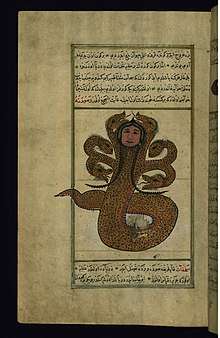Tannin (monster)
Tannin (Hebrew: תנין; Syriac: ܬܢܝܢܐ tannīnā plural: tannīnē; Arabic: التنين Tinnīn) or Tunnanu (Ugaritic: 𐎚𐎐𐎐 tnn, vocalized tu-un-na-nu[1]) was a sea monster in Canaanite, Phoenician, and Hebrew mythology used as a symbol of chaos and evil.[2]

Name
The name may derive from a root meaning "howling" or from coiling in a manner like smoke.
In modern Hebrew usage the word Tanin (תנין) means "crocodile."
Canaanite mythology
Tannin appears in the Baal Cycle as one of the servants of Yam (lit. 'Sea') defeated by Baʿal (lit. 'Lord')[3] or bound by his sister, ʿAnat.[4] He is usually depicted as serpentine, possibly with a double tail.[4]
Hebrew mythology
The tanninim (תַּנִּינִים) also appear in the Hebrew Bible's of Book of Genesis,[5] Exodus,[6] Deuteronomy,[7] Psalms,[9] Job,[10] Ezekiel,[11] Isaiah,[12] and Jeremiah.[13] They are explicitly listed among the creatures created by God on the fifth day of the Genesis creation narrative,[5] translated in the King James Version as "great whales".[14] The tannin is listed in the apocalypse of Isaiah as among the sea beasts to be slain by Yahweh "on that day",[15] translated in the King James Version as "the dragon".[16][n 1]
In Jewish mythology, Tannin is sometimes conflated with the related sea monsters Leviathan and Rahab.[19] Along with Rahab, "Tannin" was a name applied to ancient Egypt after the Exodus to Canaan.[2]
The word "Tannin" is used in the Hebrew Bible fourteen times. Aaron's staff becomes Tannin in the Book of Exodus (Ex 7:9-12), it is used in the meaning "snake" in the Book of Deuteronomy (Deut 32:33) and Psalms (Ps 91:13). It represents the Nebuchadnezzar I (the king of Babylon) in Jeremiah (Jer 51:34) and Pharaoh in Ezekiel (Ezek 29:3, 32:2). In the Book of Job (Job 7:12) the protagonist questions God "Am I the sea or the sea dragon that you have set a guard over me?"[20]
In modern scholarship, Tannin is sometimes associated with Tiamat and, in modern Hebrew, the name tannin means crocodile. The name has subsequently been given to three submarines in the Israeli Navy: the first, an S-class submarine formerly known as HMS Springer, was in commission from 1958 until 1972. The second, a Gal-class submarine, was in commission from 1977 until 2002. The third INS Tanin is a Dolphin-class submarine in commission since 2014.
See also
Notes
- This passage in Isaiah directly parallels another from the earlier Baal Cycle. The Hebrew passage describing the tannin takes the place of a Ugaritic one describing "the encircler"[17] or "the mighty one with seven heads" (šlyṭ d.šbʿt rašm).[18] In both the Ugaritic and Hebrew texts, it is debatable whether three figures are being described or whether the others are epithets of Lotan or Leviathan.
References
Citations
- Day (1985), p. 5.
- Heider (1999), p. 836.
- Herrmann (1999), p. 135.
- Heider (1999), p. 135.
- Gen. 1:21.
- Exod. 7:9–10:12.
- Deut. 32:33.
- Heider (1999), p. 135–136.
- Ps. 74:13, 91:13, 148:7, and possibly 44:20.[8]
- Job 7:12.
- Ezek. 29:3 & 32:2.
- Isa. 27:1 & 51:9.
- Jer. 51:34.
- Gen. 1:21 (KJV).
- Isa. 27:1.
- Isa. 27:1 (KJV).
- Barker (2014), p. 152.
- Uehlinger (1999), p. 512.
- Heider (1999), pp. 835–836.
- Dictionary of the Old Testament. Intervarsity Press. p. 46. Retrieved 25 August 2019.
Bibliography
- Barker, William D. (2014), "Litan in Ugarit", Isaiah's Kingship Polemic: An Exegetical Study in Isaiah 24–27, Tübingen: Mohr Siebeck, pp. 151–167, ISBN 978-3-16-153347-1.
- Day, John (1985). God's Conflict with the Dragon and the Sea: Echoes of a Canaanite Myth in the Old Testament. CUP Archive. p. 5. ISBN 978-0-521-25600-1.
- Heider, George C. (1999), "Tannîn", Dictionary of Deities and Demons in the Bible, 2nd ed., Grand Rapids: Wm. B. Eerdmans Publishing, pp. 834–836.
- Herrmann, Wolfgang (1999), "Baal", Dictionary of Deities and Demons in the Bible, 2nd ed., Grand Rapids: Wm. B. Eerdmans Publishing, pp. 132–139.
- Uehlinger, C. (1999), "Leviathan", Dictionary of Deities and Demons in the Bible, 2nd ed., Grand Rapids: Wm. B. Eerdmans Publishing, pp. 511–515.